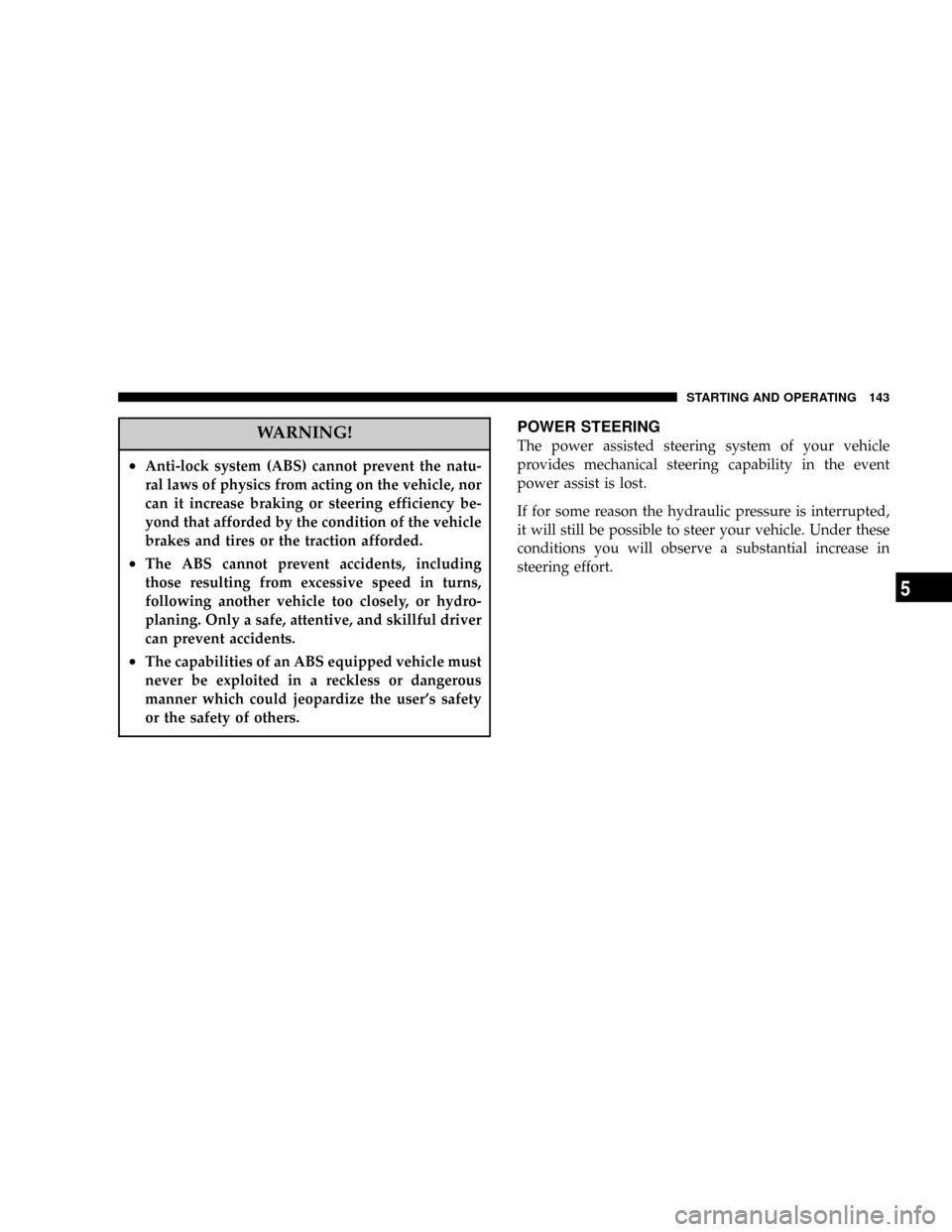2004 CHRYSLER SEBRING CONVERTIBLE power steering
[x] Cancel search: power steeringPage 46 of 271

NInterior Lights........................64
NMulti-Function Control Lever..............66
NHeadlights, Parking Lights, Instrument Panel
Lights..............................66
NDaytime Running Lights (Canada Only)......66
NLights-On Reminder....................67
NFog Lights Ð If Equipped................67
NTurn Signals..........................67
NHeadlight Beam Select Switch.............67
NPassing Light.........................67
NHeadlight Time Delay...................67
mWindshield Wipers And Washers...........68
NMist................................68
NSpeed Sensitive Intermittent Wiper System....69
mTilt Steering Column.....................69
mTraction ControlÐ If Equipped.............70
mElectronic Speed ControlÐ If Equipped......70
NTo Activate...........................71
NTo Set At A Desired Speed................71
NTo Deactivate.........................71
NTo Resume Speed......................71
NTo Vary The Speed Setting................71
NTo Accelerate For Passing................72
NUsing Speed Control On Hills.............72
mGarage Door Opener Ð If Equipped.........73
NProgramming The Universal Transceiver......74
NªRolling Codeº Programming.............75
NCanadian Programming/Gate Programming . . .77
NOperation............................77
NReprogramming A Single Button...........77
NSecurity.............................77
mElectrical Power Outlet...................78
46 UNDERSTANDING THE FEATURES OF YOUR VEHICLE
Page 70 of 271

TRACTION CONTROLÐ IF EQUIPPED
To turn the Traction Control System Off, press
the switch located on the top of the steering
column, to the right of the hazard switch, until
the Traction Control indicator in the instrument
cluster lights up.
To turn the Traction Control System On, press the switch
until the Traction Control indicator in the instrument
cluster turns off.
NOTE:The Traction Control System is enabled each
time the ignition switch is turned On. This will occureven if you used the switch to turn the system off before
powering down or turning the ignition to Lock.
ELECTRONIC SPEED CONTROLÐ IF EQUIPPED
When engaged, this device will control the throttle op-
eration to maintain a constant vehicle speed between 30
mph (48 km/h) and 85 mph (137 km/h). The controls are
on the steering wheel.
70 UNDERSTANDING THE FEATURES OF YOUR VEHICLE
Page 118 of 271

²Pressing the AM/FM button while in the tape or CD
mode will select the radio mode.
²If in the CD mode and the last CD is ejected, the radio
will tune to the last station selected.
Removing Discs from the CD Changer
If there is a single CD in the changer, press the EJT button
and the CD will eject. If the CD is not removed within 15
seconds, it will automatically reload into the CD changer.
To eject additional CDs from the changer, first select the
numbered button where the CD is located and then press
the EJT button.
CD Changer Operation with the Changer Off
The CD changer is able to load and eject discs with the
ignition power off. However, while the ignition is off, one
of the six numbered buttons must be pressed first.
REMOTE SOUND SYSTEM CONTROLS Ð IF
EQUIPPED
The remote sound system controls are located on the rear
surface of the steering wheel. Reach behind the wheel to
access the switches.
The right hand control is a rocker type switch with a
push-button in the center and controls the volume and
mode of the sound system. Pressing the top of the rocker
switch will increase the volume and pressing the bottom
of the rocker switch will decrease the volume.
118 UNDERSTANDING YOUR INSTRUMENT PANEL
Page 130 of 271

NAnti-Lock Brake System (ABS) Ð If
Equipped...........................142
mPower Steering........................143
mTraction Control Ð If Equipped...........144
mTire Safety Information..................145
NTire Markings........................145
NTire Identification Number (TIN)..........148
NTire Loading And Tire Pressure...........149
mTiresÐGeneral Information...............152
NTire Pressure.........................152
NTire Inflation Pressures.................153
NRadial-Ply Tires......................155
NCompact Spare Tire Ð If Equipped.........155
NTire Spinning........................156
NTread Wear Indicators..................157
NReplacement Tires.....................157NAlignment And Balance.................158
mTire Chains...........................159
mSnow Tires...........................159
mTire Rotation Recommendations...........159
mAutoStick Ð If Equipped................160
NAutoStick Operation...................160
NAutoStick General Information............161
mFuel Requirements.....................162
NReformulated Gasoline.................162
NGasoline/Oxygenate Blends..............162
NMMT In Gasoline.....................163
NSulfur In Gasoline.....................163
NMaterials Added To Fuel................164
mAdding Fuel..........................164
NFuel Filler Cap (Gas Cap)...............164
mVehicle Loading.......................166
130 STARTING AND OPERATING
Page 143 of 271

WARNING!
²Anti-lock system (ABS) cannot prevent the natu-
ral laws of physics from acting on the vehicle, nor
can it increase braking or steering efficiency be-
yond that afforded by the condition of the vehicle
brakes and tires or the traction afforded.
²The ABS cannot prevent accidents, including
those resulting from excessive speed in turns,
following another vehicle too closely, or hydro-
planing. Only a safe, attentive, and skillful driver
can prevent accidents.
²The capabilities of an ABS equipped vehicle must
never be exploited in a reckless or dangerous
manner which could jeopardize the user's safety
or the safety of others.
POWER STEERING
The power assisted steering system of your vehicle
provides mechanical steering capability in the event
power assist is lost.
If for some reason the hydraulic pressure is interrupted,
it will still be possible to steer your vehicle. Under these
conditions you will observe a substantial increase in
steering effort.
STARTING AND OPERATING 143
5
Page 187 of 271

MAINTAINING YOUR VEHICLE
CONTENTS
m2.4L Engine..........................189
m2.7L Engine..........................190
mOnboard Diagnostic System Ð OBD II......191
mEmissions Inspection And Maintenance
Programs
............................192
mReplacement Parts.....................193
mDealer Service........................193
mMaintenance Procedures.................194
NEngine Oil..........................194
NCrankcase Emission Control System........200
NMaintenance-Free Battery................200
NAir Conditioner......................201NPower Steering Fluid Check..............202
NSuspension Ball Joints..................203
NBody Mechanism Lubrication.............203
NWindshield Wiper Blades................205
NWindshield Washers...................205
NExhaust System......................206
NCooling System.......................207
NHoses And Vacuum/Vapor Harnesses.......211
NBrakes.............................211
NFuel System Hoses....................213
NAutomatic Transmission................213
7
Page 202 of 271

through the condenser as required. Fabric front fascia
protectors may reduce air flow to the condenser, reducing
air conditioning performance.
WARNING!
The air conditioning system contains refrigerant
under high pressure. To avoid risk of personal injury
or damage to the system, adding refrigerant or any
repair requiring lines to be disconnected should be
done by an experienced repairman.
Refrigerant Recovery and Recycling
The air conditioning system of your vehicle contains
R-134a, a refrigerant that does not deplete the ozone layer
in the upper atmosphere. The manufacturer recommends
that air conditioning service be done by facilities using
refrigerant recycling and recovery equipment that meets
SAE standard J1991.
Power Steering Fluid Check
Checking the power steering fluid level at a defined
service interval is not required. The fluid should only be
checked if a leak is suspected, abnormal noises are
apparent, and/or the system is not functioning as antici-
pated. Coordinate inspection efforts through a certified
ªDaimlerChrysler Dealershipº.
Before removing the reservoir cap, wipe the outside of
the cap and reservoir so that no dirt can fall into the
reservoir.
WARNING!
Fluid level should be checked on a level surface with
the engine off to prevent injury from moving parts,
and to insure accurate fluid level reading. Do not
overfill. Use only manufacturer's recommended
fluid.
202 MAINTAINING YOUR VEHICLE
Page 211 of 271

ONLY the correct type thermostat. Other designs may
result in unsatisfactory cooling performance, poor gas
mileage, and increased emissions.
Hoses and Vacuum/Vapor Harnesses
Inspect surfaces of hoses and nylon tubing for evidence
of heat and mechanical damage. Hard or soft spots,
brittle rubber, cracking, checking, tears, cuts, abrasions,
and excessive swelling indicate deterioration of the rub-
ber.
Pay particular attention to those hoses nearest to high
heat sources such as the exhaust manifold. Inspect hose
routing to be sure hoses do not touch any heat source or
moving component that may cause heat damage or
mechanical wear.
Insure nylon tubing in these areas has not melted or
collapsed. Inspect all hose connections such as clamps
and couplings to make sure they are secure and no leaks
are present. Components should be replaced immedi-
ately if there is any evidence of degradation that could
cause failure.
Brakes
In order to assure brake system performance, all brake
system components should be inspected periodically.
Suggested service intervals can be found in section 8.
WARNING!
Riding the brakes can lead to brake failure and
possibly an accident. Driving with your foot resting
or riding on the brake pedal can result in abnormally
high brake temperatures, excessive lining wear, and
possible brake damage. You may not have your full
braking capacity in an emergency.
Brake and Power Steering System Hoses
When servicing the vehicle for scheduled maintenance,
inspect surface of hoses and nylon tubing for evidence of
heat and mechanical damage. Hard and brittle rubber,
cracking, checking, tears, cuts, abrasion, and excessive
swelling suggest deterioration of the rubber. Particular
attention should be made to examining those hose sur-
faces nearest to high heat sources, such as the exhaust
manifold.
MAINTAINING YOUR VEHICLE 211
7